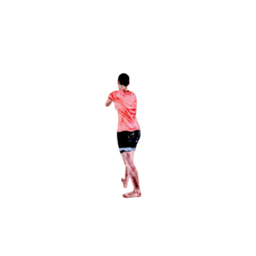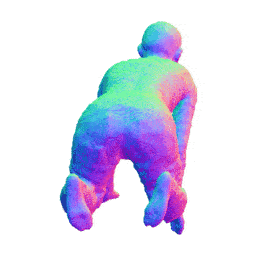A-NeRF: Articulated Neural Radiance Fields for Learning Human Shape, Appearance, and Pose
Shih-Yang Su, Frank Yu, Michael Zollhoefer, and Helge Rhodin
Thirty-Fifth Conference on Neural Information Processing Systems (NeurIPS 2021)
- Jan 10, 2022: update reference code for multiview pose optimization with uncalibrated cameras.
conda create -n anerf python=3.8
conda activate anerf
# install pytorch for your corresponding CUDA environments
pip install torch
# install pytorch3d: note that doing `pip install pytorch3d` directly may install an older version with bugs.
# be sure that you specify the version that matches your CUDA environment. See: https://github.com/facebookresearch/pytorch3d
pip install pytorch3d -f https://dl.fbaipublicfiles.com/pytorch3d/packaging/wheels/py38_cu102_pyt190/download.html
# install other dependencies
pip install -r requirements.txt
We provide pre-processed data in .h5 format, as well as pre-trained characters for SURREAL and Mixamo dataset.
Please see data/README.md for details.
You can use run_render.py to render the learned models under different camera motions, or retarget the character to different poses by
python run_render.py --nerf_args logs/surreal_model/args.txt --ckptpath logs/surreal_model/150000.tar \
--dataset surreal --entry hard --render_type bullet --render_res 512 512 \
--white_bkgd --runname surreal_bullet
Here,
--datasetspecifies the data source for poses,--entryspecifices the particular subset from the dataset to render,--render_typedefines the camera motion to use, and--render_resspecifies the height and width of the rendered images.
Therefore, the above command will render 512x512 the learned SURREAL character with bullet-time effect like the following (resizsed to 256x256):
The output can be found in render_output/surreal_bullet/.
You can also extract mesh for the learned character:
python run_render.py --nerf_args logs/surreal_model/args.txt --ckptpath logs/surreal_model/150000.tar \
--dataset surreal --entry hard --render_type mesh --runname surreal_mesh
You can find the extracted .ply files in render_output/surreal_mesh/meshes/.
To render the mesh as in the paper, run
python render_mesh.py --expname surreal_mesh
which will output the rendered images in render_output/surreal_mesh/mesh_render/ like the following:
You can change the setting in run_render.py to create your own rendering configuration.
We provide template training configurations in configs/ for different settings.
To train A-NeRF on our pre-processed SURREAL dataset,
python run_nerf.py --config configs/surreal/surreal.txt --basedir logs --expname surreal_model
The trained weights and log can be found in logs/surreal_model.
To train A-NeRF on our pre-processed Mixamo dataset with estimated poses, run
python run_nerf.py --config configs/mixamo/mixamo.txt --basedir log_mixamo/ --num_workers 8 --subject archer --expname mixamo_archer
This will train A-NeRF on Mixamo Archer with pose refinement for 500k iterations, with 8 worker threads for the dataloader.
You can also add --use_temp_loss --temp_coef 0.05 to optimize the pose with temporal constraint.
Additionally, you can specify --opt_pose_stop 200000 to stop the pose refinement at 200k iteraions to only optimize the body models for the remaining iterations.
To finetune the learned model, run
python run_nerf.py --config configs/mixamo/mixamo_finetune.txt --finetune --ft_path log_mixamo/mixamo_archer/500000.tar --expname mixamo_archer_finetune
This will finetune the learned Mixamo Archer for 200k with the already refined poses. Note that the pose will not be updated during this time.
@inproceedings{su2021anerf,
title={A-NeRF: Articulated Neural Radiance Fields for Learning Human Shape, Appearance, and Pose},
author={Su, Shih-Yang and Yu, Frank and Zollh{\"o}fer, Michael and Rhodin, Helge},
booktitle = {Advances in Neural Information Processing Systems},
year={2021}
}
- The code is built upon nerf-pytorch.
- We use SPIN for estimating the initial 3D poses for our Mixamo dataset.
- We generate the data using SURREAL and Adobe Mixamo characters.


